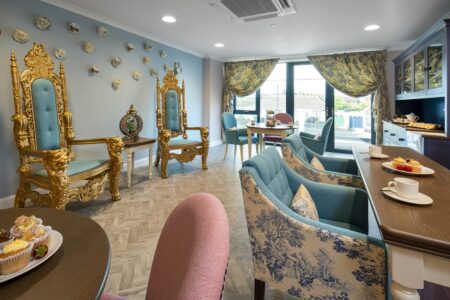Dementia design: Hotel vs Care Home
This article explores how dementia-inclusive design needs to focus on the traditional rather than creating high-end hotel-like interiors often seen in modern care facilities

A world leader for knowledge exchange and research impact dedicated to improving the lives of people with dementia is Stirling University’s Dementia Services Development Centre (DSDC).
Established in 1989, the centre uses research to inform practice, and practice to inform research, providing comprehensive resources for anyone supporting someone living with dementia, both personally and professionally.
And it has led the way in creating tools and guidance for health and care providers, working with medical architects, care home operators, and health organisations to make all environments inclusive and supportive of people with dementia.
Speaking to Healthcare Property, Lynsey Hutchinson, the DSDC’s senior interior designer, said: “There is a need to better understand the realities of the disease and to create environments that are truly supportive.
“Dementia is not a normal condition of ageing, but ageing is a key risk factor in developing dementia.
“Older people may have sight and hearing problems, mobility issues, and breathing difficulties, and we need to consider all of these when designing buildings.”

Familiarity is critical when designing for people with dementia
Familiarity
She added: “To create truly dementia-inclusive environments, we need to involve people with lived experience and care professionals in the design phase, not just the care operator, the developer, or the architect.”
In particular, key to good dementia-inclusive design is familiarity.
With care homes, in particular, operators are primarily targeting families of older people who will often be choosing, or paying for, their relatives’ care in later life.
But this has resulted in a tendency to create interiors designed to mimic upmarket hotels.
And Hutchinson warns: “We need to think less about attracting the family and more about creating environments that are more homely for people living with dementia.
“We need to go back to interiors which are more domestic and familiar.”
This is an approach supported by Kerry Southern-Reason, chief executive of Care Home Interiors Group.
She told Healthcare Property: “We try hard to make sure the interiors are homely rather than hotel like.
“Bedrooms, especially, should be as near to a home environment as possible.
“In a report called Design for Dementia by Gregor Timlin and Nic Rysenbry the authors say: ‘The bedroom is the one place in the care home that can reinforce personal identity and act as a place of refuge’.

To create truly dementia-inclusive environments, designers need to involve people with lived experience and care professionals
Comfort and safety
“I couldn’t agree more with this comment – a bedroom should be familiar and provide a sense of comfort and safety.
“For instance, we can’t get away from using profile beds. However, we do everything in our power to disguise them, so they don’t look like an intimidating medical bed.
“We use valances to hide the rails and upholster them so, visually, it looks like a normal bed.”
Another aspect of hotel interiors is in-line furniture; sleek, fitted media walls; and storage.
“Designed to fulfil a function, it does its job, but it isn’t the type of furniture you would associate with being in a domestic home” said Southern-Reason.
“For many it’s too much of a disconnect from a ‘homely’ interior.
“That’s why the furniture we specify is solid.
“Manufactured in-house, we use solid natural surfaces, favouring free-standing furniture.
“Although it must fit back to the walls to be safe and CQC compliant, it is more in keeping with bedrooms in domestic home.
“This is especially relevant to someone with dementia and we are always mindful of an individual’s lived experience when creating what will be their living experiences.
“A bedroom should be as familiar as possible, making it clearly identifiable as a domestic bedroom provides the additional reassurances required.”

Bedrooms, in particular, need to look traditional, not like high-end hotels or hospitals, according to Kerry Southern-Reason, chief executive of Care Home Interiors Group
Home from home
The domestic essence should not be lost in other rooms, either. “The lounge and dining rooms should be far more in keeping with what you have at home,” said Southern-Reason.
“Clearly, they have a need to be much larger, but picking up on the ‘essence’, we use tables with solid tops which might feature a tablecloth or top protectors in some cases.
“We also use dressers to add an additional of ‘homely’ dimension; dressed with crockery, cups, plates, pots, canisters – anything that indicates the room is to dine in and ignites memories of home life is our aim.
“Making it familiar is incredibly important.
“We recognise the space must be fit for purpose, but it doesn’t have to compromise on delivering a domestic atmosphere.
“Soft seating is homely, although preferably wipe clean to easily manage infection and prevention control.
“We always steer well clear of the typical austere healthcare environment.”
A clear purpose
Hutchinson adds: “Multi-functional spaces are a real issue in many new builds.
“It’s about creating spaces which can be used as a dining area one minute and maybe an arts and crafts space the next, but this can be very confusing for people with dementia.
“It is hard to remove all associated furniture and fixtures and this creates clutter and makes it hard for someone with dementia to properly understand the function of a room.
“A dining room, for example, should be very easily identified, with glazing showing someone what the purpose of the room is before they have entered it.
“Good dementia design is about creating smaller spaces with specific and clear functions.”
However, there are some areas where a more-hotel-like design can be beneficial.
Southern-Reason explains: “Where I think you can take hotel design into a care home is the social spaces – spaces that you go to as a day out.
“A lot of care home residents with mobility issues or nursing needs don’t have the opportunity to leave the care home.
“Therefore, places like the hair salon, library, cinema, the private dining room, café, or any space that isn’t within the living areas, should be geared more towards a hotel design.
“While safety must be the ultimate priority, you can still push the boundaries to achieve that more-adventurous look.

More high-end design can be utilised in communal spaces such as dining areas and cinemas
“For instance, a recent design element we used in a private dining room was wall cutouts. It isn’t what you’d have in your private home, but in this care home we placed interesting items in the cut-outs and placed display lights in them, making them an unusual feature and point of interest to talk around.
“The reason and thinking behind this is visiting a more-social space in a care home becomes an outing and an occasion, much like it feels for us when we go out for a meal, to the cinema or hair salon. It’s a special experience that we all enjoy very much.”
She concludes: “On balance, some parts of a care home can be more hotel like, but in the day-to-day living spaces you don’t want to live in a hotel.
“We all love visiting hotels, but most people wouldn’t want to live in them. Nor do we feel anyone looking to live in a care home would be attracted by living in a hotel-like environment.
“Sadly, some care homes aren’t particularly homely. They photograph very well and look nice, but you do have to take a step back and ask yourself ‘would I want to live there’ and that’s what we do when designing a care home.”
